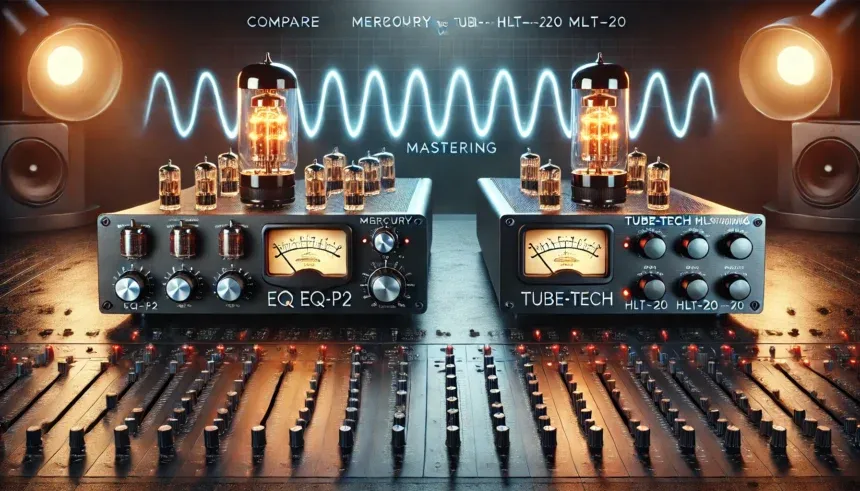Compare Mercury EQ-P2 vs. Tube-Tech HLT-20 Mastering: Vintage Character or Modern Control?
Mastering equalizers help shape the final sound of a mix, adding clarity, depth, and warmth. Think of them as the...

Mastering equalizers help shape the final sound of a mix, adding clarity, depth, and warmth. Think of them as the finishing touches that bring your audio masterpiece to life. Two top contenders in the mastering world are the Mercury EQ-P2 and Tube-Tech HLT-20. These units offer distinct approaches to EQ processing, each with its own strengths.
The Mercury EQ-P2 is a Pultec-style passive equalizer known for its vintage analog warmth, while the Tube-Tech HLT-20 offers modern precision with active shelving and tube-driven character. In this comparison, we’ll explore their sound quality, features, usability, and ideal applications, helping you decide which one fits your needs.
There are several types of EQs. You can learn some of them by watching this 10 minute video.
Design & Build Quality
Mercury EQ-P2
The Mercury EQ-P2 takes inspiration from the legendary Pultec EQP-1A, featuring a fully analog signal path and passive equalization. It’s built with high-quality transformers and capacitors, delivering exceptional warmth and musicality. Its vintage design is straightforward, sticking closely to the original Pultec setup, making it an excellent tool for tone shaping in a traditional way.
Tube-Tech HLT-20
The Tube-Tech HLT-20 combines active shelving EQ with a tube-driven stage, offering greater precision in frequency adjustments. Its design incorporates high-end components for durability and professional-grade performance. Unlike the Mercury EQ-P2, the HLT-20 includes modern features like a user-friendly interface for real-time adjustments, making it easier to work with during sessions.
Build & Usability Differences
While both units are durable and designed for professional studios, they serve different workflows. The Mercury EQ-P2 is ideal for broad, musical tone shaping, while the Tube-Tech HLT-20 is built for those who need more control and surgical precision, without losing the warmth of tube circuitry.
Sound Quality & Tonal Characteristics
Mercury EQ-P2
The Mercury EQ-P2 is known for its smooth, rich tonal character, especially in the low-end and high frequencies. The classic Pultec-style boost and attenuation controls allow for natural tonal shaping, adding warmth and depth without muddying the mix. It’s perfect for vintage and analog-style recordings, bringing an organic feel to your sound.
Read More : Difference Between a 10GSR-85-1 and a 10GLR31

Tube-Tech HLT-20
The Tube-Tech HLT-20, on the other hand, excels in precision. Its active shelving EQ provides more control over frequencies, making it ideal for mastering that requires surgical tonal balance. While it retains warmth from the tube circuitry, the response is cleaner and more controlled, making it a great fit for modern, polished mastering.
Color vs. Transparency
The Mercury EQ-P2 offers coloration and warmth, enhancing character and richness. The Tube-Tech HLT-20 is more transparent, providing balanced control that’s ideal for clear, defined mixes.
Features & Functionality
| Feature | Mercury EQ-P2 | Tube-Tech HLT-20 |
| EQ Type | Passive, Pultec-style | Active shelving + tube-driven |
| Tonal Character | Smooth, vintage warmth | Controlled, modern clarity |
| Flexibility | Classic tone-shaping | Precise EQ sculpting |
| Best For | Analog warmth & depth | Balanced, controlled mastering |
EQ Type: Passive vs. Active
The Mercury EQ-P2 uses passive equalization, relying on high-quality transformers and tubes for its sound. The Tube-Tech HLT-20 features active shelving EQ, allowing for more precise frequency adjustments.
Control Layout
The Mercury EQ-P2 sticks with the classic Pultec boost/cut system, giving engineers broad tonal shaping control. The Tube-Tech HLT-20, however, offers more flexibility with an intuitive active shelving design, making it easier to perform precise EQ adjustments.
Flexibility
The Mercury EQ-P2 shines in classic tonal shaping, but it’s not as versatile as modern EQs. The Tube-Tech HLT-20 excels in precision, making it better suited for fine-tuned, detailed frequency work.
Application in Mastering
Best Use Cases
- Mercury EQ-P2: Ideal for adding warmth, depth, and musicality to genres like vintage jazz, rock, and analog recordings.
- Tube-Tech HLT-20: Perfect for modern electronic, orchestral, and pop productions, where precision and clarity are key.
Which One for Specific Genres?
- Rock, Jazz, and Analog Recordings: The Mercury EQ-P2’s vintage warmth is perfect for these genres.
- Electronic, Orchestral, and Pop Mastering: The Tube-Tech HLT-20 provides the precise control needed for these genres.
Do They Complement Each Other?
Absolutely! The Mercury EQ-P2 and Tube-Tech HLT-20 can work together in a hybrid setup. Use the Mercury EQ-P2 for vintage warmth and analog depth, and the Tube-Tech HLT-20 for detailed, controlled tonal balance.
Pros & Cons of Each Equalizer
Mercury EQ-P2
✅ Pros:
- Classic analog warmth and musicality.
- Smooth low-end boost without muddiness.
- Ideal for vintage and analog-style mastering.
- Simple, effective controls for easy EQ shaping.
❌ Cons:
- Less precise than modern EQs.
- Limited flexibility for detailed adjustments.
- Large, bulky design.
Tube-Tech HLT-20
✅ Pros:
- Greater control over frequencies with active shelving.
- Warmth from tube circuitry with modern clarity.
- Perfect for precise tonal balance.
- Easily integrates into hybrid workflows.
❌ Cons:
- Not as “vibey” as a true Pultec-style EQ.
- Steeper learning curve due to its unique shelving design.
- More clinical sound, which may lack the character some engineers desire.
Conclusion: Which One is Right for You?
Both the Mercury EQ-P2 and Tube-Tech HLT-20 offer exceptional capabilities for mastering, but they cater to different needs.
- If you’re after vintage analog warmth and rich character, the Mercury EQ-P2 is your go-to.
- If you need precise tonal control with tube warmth, the Tube-Tech HLT-20 is your best bet.
For engineers who want a combination of both, a hybrid setup using the Mercury EQ-P2 for warmth and the Tube-Tech HLT-20 for precision could offer the best of both worlds.
Ultimately, the right choice comes down to your workflow, the genre you’re mastering, and the tonal results you want to achieve. Both equalizers bring something special to the table, whether it’s the smooth vintage vibe of the Mercury EQ-P2 or the modern precision of the Tube-Tech HLT-20.



